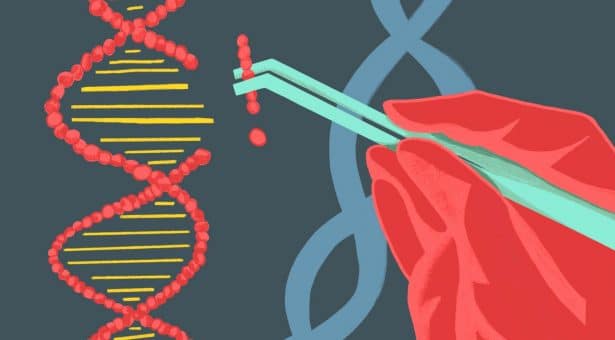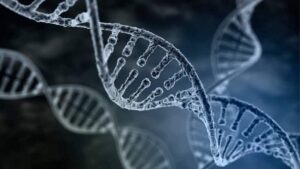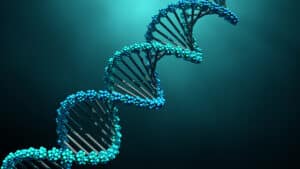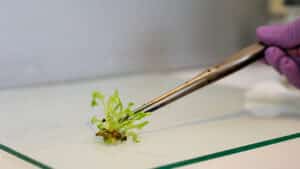The discovery of DNA has enabled everything from agriculture to pharmaceutical advancements, making the material an intricate part of present-day innovations.
Scientific and technological advances have paved the way for extraordinary progress in genetics, and to commemorate the magnitude of these discoveries, National DNA Day is honored.
National DNA Day celebrates the completion of the Human Genome Project and the breaking discovery of the double helix, according to the National Human Genome Research Institute (NIH).
In case of agriculture, DNA has enabled discoveries in plant and animal sciences that might not have been possible before-and these technologies became available along with completing the Human Genome Project early 2000. Dick Roelofs, Program Scientist and Team Leader of the DNA Innovations team at KeyGene, gives credit to DNA for speeding up the breeding process and bringing better crops to the market.
“So, whereas before, when DNA information was hardly available, the time to get to market for a new crop was tremendous. I mean, 10 to 15 years was kind of common. Now, you see crops becoming available on the market as fast as within five years . We should put that on the account of DNA and using DNA tools in plant breeding,” says Roelofs.
Where it All Began
DNA was first discovered in 1869 by Swiss researcher Friedrich Miescher.
Gregor Mendel then spearheaded DNA in plants with his experiments on peas from 1856-1863.
The ‘father of genetics’ looked at seven characteristics in peas, including plant height, seed colour and whether the seeds were wrinkly or smooth. Through his work on pea plants, he discovered the fundamental laws of inheritance.
He deduced that genes come in pairs and are inherited as distinct units, one from each parent. Mendel tracked the segregation of parental genes and their appearance in the offspring as dominant or recessive traits. He recognized the mathematical patterns of inheritance from one generation to the next.
It was through Mendel’s insights that scientists were able to greatly expand our understanding of the complexities of genetic inheritance. That understanding led to the development of new experimental methods, more efficient plant breeding and much better plant varieties.
With this and other discoveries, plant breeders all around the world will continue to develop higher yielding plant varieties, with better resistances to pests and diseases, higher nutritional content, drought tolerance and much more.
What’s the Future of DNA Research?
According to Roelofs, a huge next step for DNA research is to understand variation in the entire set of genes for a specific crop.
“We always thought that if we had information on one genome, we would know everything about one single crop. Well, that is, of course, not the truth. Right now, we realize that there is no single golden truth about DNA, that’s where the concept called the ‘Pan-Genome’ comes in,” explains Roelofs.
“We need to have the information from a variety of lines from a certain crop to be able to quantify and to better understand genetic variation associated with breeding traits, and it’s a very big challenge to set this up. So, this is the Pan-Genomics concept where we don’t lean back on one reference genome, but we try to understand and compare genomes among certain crop lines to better understand variation associated with important breeding traits.”
Understanding the genetic codes of each crop could pave the path for faster innovations in all crops, including so-called orphan crops. This DNA information, paired with other new technologies such as gene editing, marker-assisted selection or other mathematics-based systems is something researchers are eagerly working through to create innovations faster.
For example, Nature Source Improved Plants (NSIP) uses something called operations research with their breeding partners, according Steve Tanksley, CEO of NSIP in a recent episode of Seed Speaks. It uses specialized mathematic equations, genetics and other parameters related to time or finances or specific desired characteristics to help find crop solutions faster.
In addition to large acre crops, Tanksley and team is working closely with orphan crops – crops with little to no research or data – to discover advancements. This is significant because it marks another area in which technology and better understanding of DNA can help provide genetic information about orphan crops in a cost-effective, efficient way that could make a difference in otherwise under-researched crops.
Single-cell genomics in plants is another advancement that scientists are working on.
“I think another major breakthrough technology relates to reading out DNA at the single cell level. That’s a very promising technology now in the medical area, and I anticipate it’s going to be a big rewarding challenge as well in plant breeding,” says Roelofs. “Usually, we analyze bulk RNA expression information from a whole tissue sample of a plant. However, an infection of a plant pathogen, for instance, happens locally, and we’re pretty sure we miss subtle changes within an early infection period that may be crucial to find new leads for pathogen resistance. So, we probably oversee a lot of very important interactions by not being able to dig into single cell information at-the-moment that we want to know it.”
When it comes to extracting DNA, plant samples are particularly challenging due to the high content of PCR-inhibiting compounds like polyphenols, tannins and alkaloids. We are still looking for solutions to get rid of these inhibitors, while retrieving DNA of ultra-high molecular weight still remains a challenge as well.
“Finally, if you extract DNA or RNA from a plant, you will mess up the tissue structure context,” Roelofs elaborates. “We are currently developing technology to keep tissue structure intact and still be able to read out DNA and RNA information, a principle called ‘Spatial Biology’. If successful, this will give us so much more power to discover faster and more precise which genetic factors will play an important role in breeding traits.”
DNA and Data
In addition to DNA advancements, cloud technology is another factor moving discoveries along much quicker. Cloud technology is used to collect, analyze and store data, which allows farmers and scientists to see real-time information to better understand crop conditions.
“The data is there, we just need to be able to observe, collect and access that data in a meaningful way. With that, a lot of these cloud technologies that have come about in the past five or ten years not only gives us more storage of large amounts of data, but also allows breeders to access and link that data in much more efficient ways,” explains Jesse Gilsinger, BASF Soybean Breeding Lead in an episode of Seed Speaks.
With better understanding of DNA and plant genetics overall, combined with more computational abilities, the future of plant breeding is bright.
Read More About DNA Discoveries and Cloud Technology:
No Need to Look for the Needle in the DNA-stack When You Can Create One Yourself
“Ray Guns” Let Scientists Use Light Instead of DNA to Tell Plant Populations Apart
WUR Unravels the DNA of Lettuce
Study Reveals DNA Secrets of 100 Tomato Types













